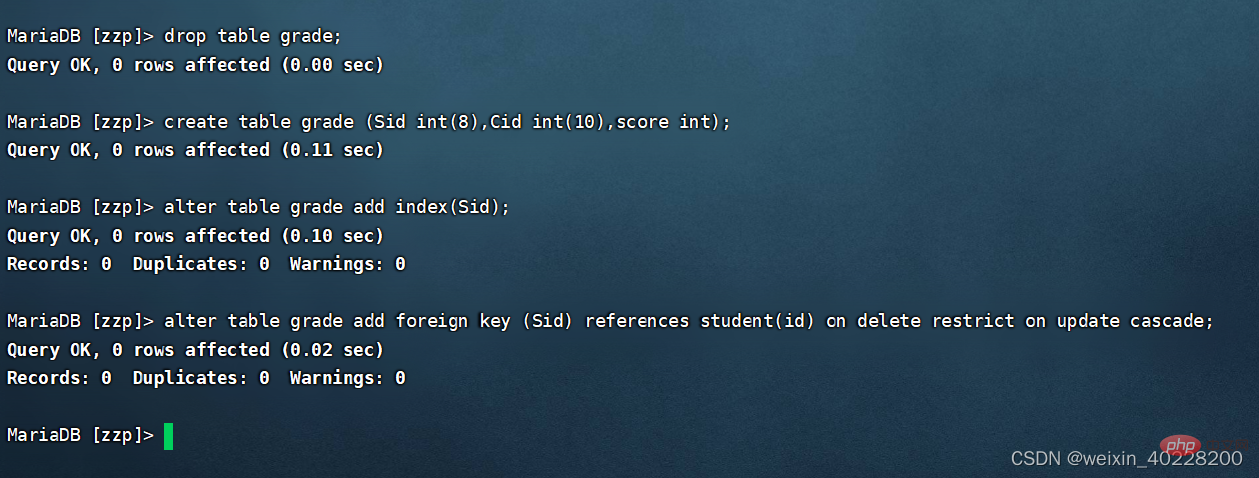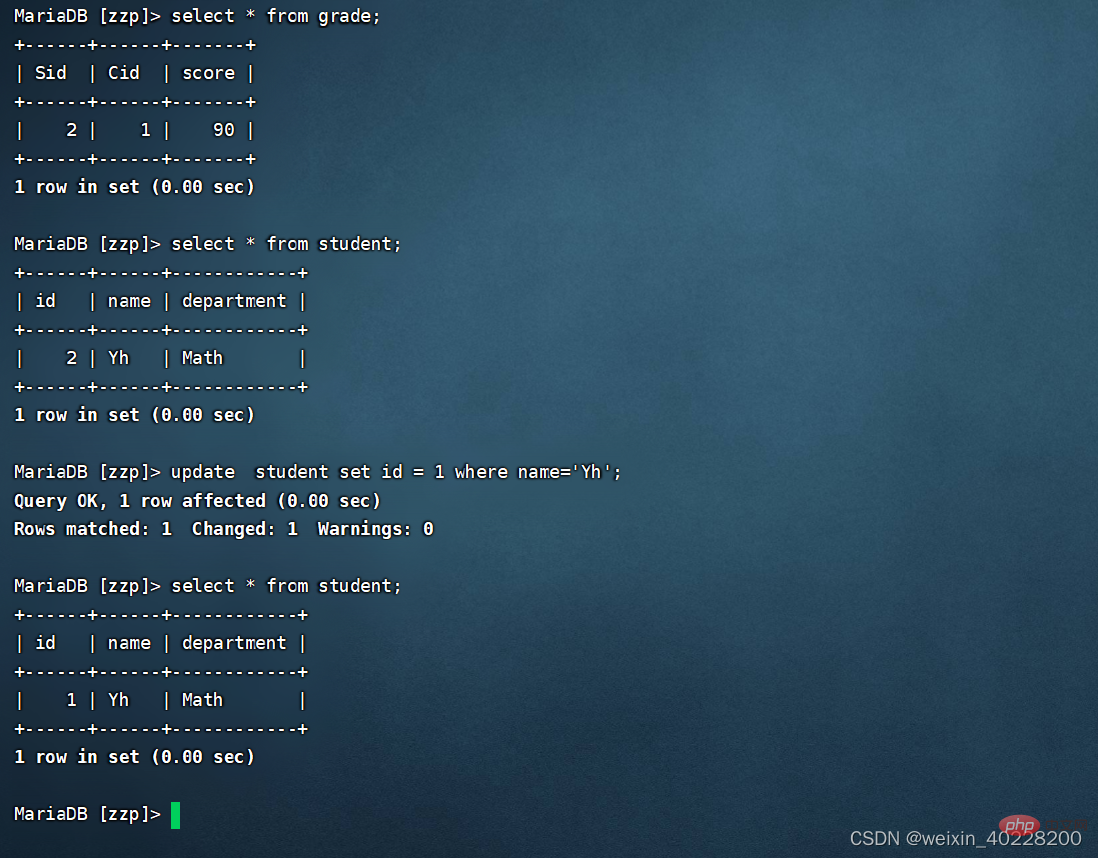Summary of MySQL foreign key constraint knowledge points
This article brings you relevant knowledge about mysql, which mainly organizes the related issues of foreign key constraints. Foreign key constraints (Foreign Key) are between two data tables in the database. A connection established by a certain column. This connection is usually caused by fields with exactly the same meaning in actual scenarios. Let’s take a look at them together. I hope it will be helpful to everyone.

Recommended learning: mysql video tutorial
1. The role of MySQL foreign key constraints
Foreign key constraints ( Foreign Key) is a relationship established by a column between two data tables in the database. This connection is usually caused by fields with exactly the same meaning in actual scenarios. Through the introduction of foreign key constraints, MySQL can make the data integrity in the data table stronger and more consistent with the display situation. Below, I give an example to illustrate the role of MySQL foreign key constraints.
If we build a database for the university student performance management system, there are two tables. One table is the student table, which stores the student's student number, name, gender, department and other information, and the other table is the grade table. Information such as student ID number, course number, test scores, etc. are stored. In this way, a foreign key constraint will be established between the two tables through the student number. It is natural for us to think that the student ID number in the transcript table depends on the existence of the student ID number in the student table. If a student graduates, or drops out, and is deleted from the student table, then his related grades are not necessary in the transcript table. exists. Before creating a foreign key relationship, these two tables exist completely independently. We can forcibly insert a related score of a non-existent student into the score table, or we can forcibly delete a student in the student table, regardless of the score information. Whether it exists in the score sheet. However, after establishing a foreign key relationship, the MySQL database will constrain the above two behaviors. Every time data is inserted or deleted, the data integrity will be checked, so that our operations must conform to the actual situation.
2. Creation of foreign key constraints
(1) Conditions for creating foreign key constraints
To create a foreign key in MySQL database, the following four things need to be met conditions, otherwise it will be rejected by the MySQL database:
1. The table and columns used to create the foreign key exist
2. The columns that make up the foreign key exist in the index
3. The engine of the data table must be specified as InnoDB
4. The data types of foreign key fields and related fields must be consistent
(2) Create foreign key constraints when creating a data table
Create when creating a data table For foreign key constraints, you only need to use the foreign key keyword to specify the foreign key fields of this table after the create statement of the data table, use the reference keyword to specify the related fields of the related table, and clearly constrain the behavior.
An example of a SQL statement to create a foreign key constraint is as follows:
create table student (id int(8),name varchar(20),department varchar(20) ,index (id))ENGINE=InnoDB; create table grade (Sid int(8),Cid int(10),score int,index(Sid),foreign key (Sid) references student(id) on delete restrict on update cascade)ENGINE=InnoDB;
In the above SQL statement, on delete restrict indicates that the foreign key will restrict the deletion operation when deleting, while on update cascade refers to the name The update operation will be synchronized when updating.
(3) Add foreign key constraints after creating the data table
Similarly, MySQL also supports adding foreign key constraints after creating the data table. In the above example, we first delete the grade table, and then create the grade table. We do not create foreign keys now. Try adding foreign keys after creating the grade table. The relevant SQL commands are as follows:
drop table grade; create table grade(Sid int(8),Cid int(10),score int); alter table grade add index(Sid); alter table grade add foreign key (Sid) references student(id) on delete restrict on update cascade;
The execution results are as follows:

3. Demonstration of foreign key constraint function
Next, let’s test the function of foreign key constraint. First, try to insert a non-existing key into the grade table. The student's grades were found to be rejected:

Afterwards, I tried to delete the students whose grades existed in the student table and found to be rejected:

Immediately afterwards , we tested the MySQL foreign key constraint cascade update function and found that if the data in the student table is changed, the grade table will also change, as shown below:

Recommended learning: mysql video tutorial
The above is the detailed content of Summary of MySQL foreign key constraint knowledge points. For more information, please follow other related articles on the PHP Chinese website!

Hot AI Tools

Undresser.AI Undress
AI-powered app for creating realistic nude photos

AI Clothes Remover
Online AI tool for removing clothes from photos.

Undress AI Tool
Undress images for free

Clothoff.io
AI clothes remover

Video Face Swap
Swap faces in any video effortlessly with our completely free AI face swap tool!

Hot Article

Hot Tools

Notepad++7.3.1
Easy-to-use and free code editor

SublimeText3 Chinese version
Chinese version, very easy to use

Zend Studio 13.0.1
Powerful PHP integrated development environment

Dreamweaver CS6
Visual web development tools

SublimeText3 Mac version
God-level code editing software (SublimeText3)

Hot Topics
 1666
1666
 14
14
 1425
1425
 52
52
 1328
1328
 25
25
 1273
1273
 29
29
 1253
1253
 24
24
 Laravel Introduction Example
Apr 18, 2025 pm 12:45 PM
Laravel Introduction Example
Apr 18, 2025 pm 12:45 PM
Laravel is a PHP framework for easy building of web applications. It provides a range of powerful features including: Installation: Install the Laravel CLI globally with Composer and create applications in the project directory. Routing: Define the relationship between the URL and the handler in routes/web.php. View: Create a view in resources/views to render the application's interface. Database Integration: Provides out-of-the-box integration with databases such as MySQL and uses migration to create and modify tables. Model and Controller: The model represents the database entity and the controller processes HTTP requests.
 MySQL and phpMyAdmin: Core Features and Functions
Apr 22, 2025 am 12:12 AM
MySQL and phpMyAdmin: Core Features and Functions
Apr 22, 2025 am 12:12 AM
MySQL and phpMyAdmin are powerful database management tools. 1) MySQL is used to create databases and tables, and to execute DML and SQL queries. 2) phpMyAdmin provides an intuitive interface for database management, table structure management, data operations and user permission management.
 MySQL vs. Other Programming Languages: A Comparison
Apr 19, 2025 am 12:22 AM
MySQL vs. Other Programming Languages: A Comparison
Apr 19, 2025 am 12:22 AM
Compared with other programming languages, MySQL is mainly used to store and manage data, while other languages such as Python, Java, and C are used for logical processing and application development. MySQL is known for its high performance, scalability and cross-platform support, suitable for data management needs, while other languages have advantages in their respective fields such as data analytics, enterprise applications, and system programming.
 Solve database connection problem: a practical case of using minii/db library
Apr 18, 2025 am 07:09 AM
Solve database connection problem: a practical case of using minii/db library
Apr 18, 2025 am 07:09 AM
I encountered a tricky problem when developing a small application: the need to quickly integrate a lightweight database operation library. After trying multiple libraries, I found that they either have too much functionality or are not very compatible. Eventually, I found minii/db, a simplified version based on Yii2 that solved my problem perfectly.
 Laravel framework installation method
Apr 18, 2025 pm 12:54 PM
Laravel framework installation method
Apr 18, 2025 pm 12:54 PM
Article summary: This article provides detailed step-by-step instructions to guide readers on how to easily install the Laravel framework. Laravel is a powerful PHP framework that speeds up the development process of web applications. This tutorial covers the installation process from system requirements to configuring databases and setting up routing. By following these steps, readers can quickly and efficiently lay a solid foundation for their Laravel project.
 Solve MySQL mode problem: The experience of using the TheliaMySQLModesChecker module
Apr 18, 2025 am 08:42 AM
Solve MySQL mode problem: The experience of using the TheliaMySQLModesChecker module
Apr 18, 2025 am 08:42 AM
When developing an e-commerce website using Thelia, I encountered a tricky problem: MySQL mode is not set properly, causing some features to not function properly. After some exploration, I found a module called TheliaMySQLModesChecker, which is able to automatically fix the MySQL pattern required by Thelia, completely solving my troubles.
 Explain the purpose of foreign keys in MySQL.
Apr 25, 2025 am 12:17 AM
Explain the purpose of foreign keys in MySQL.
Apr 25, 2025 am 12:17 AM
In MySQL, the function of foreign keys is to establish the relationship between tables and ensure the consistency and integrity of the data. Foreign keys maintain the effectiveness of data through reference integrity checks and cascading operations. Pay attention to performance optimization and avoid common errors when using them.
 Compare and contrast MySQL and MariaDB.
Apr 26, 2025 am 12:08 AM
Compare and contrast MySQL and MariaDB.
Apr 26, 2025 am 12:08 AM
The main difference between MySQL and MariaDB is performance, functionality and license: 1. MySQL is developed by Oracle, and MariaDB is its fork. 2. MariaDB may perform better in high load environments. 3.MariaDB provides more storage engines and functions. 4.MySQL adopts a dual license, and MariaDB is completely open source. The existing infrastructure, performance requirements, functional requirements and license costs should be taken into account when choosing.




